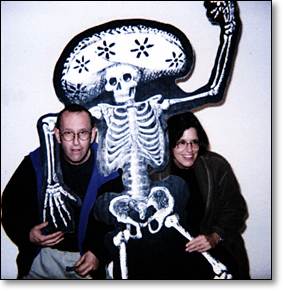
![]()
|
Mesoweb: How and when did you get interested in the Olmec?
CT: Two images have captivated me since my first exposure to Mesoamerica in Terence Grieder's undergraduate class at the University of Texas in 1973. One was Mike Coe's illustration of the Massive Offerings at La Venta, (the profile, embedded in layers of colored clays) and the other was the Olmec supernatural, formerly called "were-jaguar." To me, the conceptual complexity of the hidden Massive Offerings of green stone from 200 miles away was astounding. Similarly, the possibility of shamanic transformation (at that time championed by Peter Furst among others) opened up a new realm of epistemology and cognition for scholars to explore. These interests were suppressed during graduate school, when the thrill of decipherment of Maya glyphs and iconography drew me back to Austin from Los Angeles.
When I began to work at the Dallas Museum of Art as their Pre-Columbian curator in 1987, I began to think about an Olmec exhibition and began the long project that culminated in the National Gallery "Olmec Art of Ancient Mexico" show and the "Olmec World: Ritual and Rulership" exhibition at Princeton and Houston. For this project I involved the experts Kent Reilly and David Grove. It was a privelege to work with and learn from them.
CT: In the course of working on the exhibition-that-became-two, I travelled widely looking at Olmec objects and keeping files on them according to subject. I wanted to determine what subjects occurred in Olmec sculpture, then select the objects that best seemed to express these subjects for the exhibition. One category of subject held dwarfs, hunchbacks, and this "other" subject. The "other," of which there were about two dozen examples, was clearly distinct from the few dwarfs and hunchbacks. I had to identify them and began examining the actual objects and some photos very closely. It dawned on me that their proportions looked not like dwarfs but like infants. I got books on infants and pre-natal development and was convinced they represented late-term fetuses. When I wrote this up for the catalogue, the editors objected. They wanted to call them "fetoid". They ended up publishing a version of what I wrote, but not captioning the figures as fetuses. Obviously, I had not proven my theory well enough. So I involved an MD who in turn consulted a dozen specialists who agreed that these represented indeed late-term fetuses or neonates. They were able to identify certain developmental characteristics seen in fetuses but not in newborns. The resulting article, with Gordon Bendersky's and my attempt to survey world art for other images of fetuses, as well as to provide the Mesoamerican concepts that might illuminate the significance of these fetuses, we published in a scientific journal, Perspectives in Biology and Medicine, to give the scientific world a chance to evaluate our claim.
We received at least 90 requests for reprints for the article from biologists and MDs worldwide. All the neonatologists, peri-natologists, MDs and biologists that have commented to us personally have agreed with us. The Pre-Columbian scholars have not been as convinced. They are still squeamish about fetuses. At a recent conference on the Late Pre-Classic Maya in Austin, I got very positive feedback. Only one person said he disagreed.
CT: I don't know which exciting idea I told you about in Austin, but I have several. The corollary to having identified a significant group of Olmec sculptures (including 3 monumental ones at La Venta - larger than the Colossal Heads!) is that I think the Olmec supernatural (a.k.a. "werejaguar") represents the SEED form of humans - the embryo. In biological terms, we are embryos until 12 weeks, then transform into fetuses. In doing the research for the fetus identification, I saw many illustrations of human embryos as well. When you see the image of an embryo with slanty eyes on the side of its head, a flat nose, and a mouth that is barely distinguishable from nostrils, and a head as big as the body, you will see the UTTERLY STRIKING similarity to the Olmec supernatural. Why embryos? As I said, they are the SEED form of humans - from this, a human grows just as a maize plant grows from a maize seed (which is about the same size). As we know, maize is considered parallel to human life in many ways. I think for the Olmecs, who were early agriculturalists, this relationship extended to the seed state. This is the article I'm planning to write this summer, and it finally answers the question I had in 1973 about the Olmec supernatural! It's not a were-anything! |